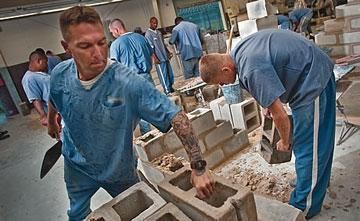
By Christopher Zoukis
In the ongoing discussion of prison reform, mass incarceration and reducing recidivism, vocational programs are often overlooked in favor of formal educational courses and other activities and programming.
Maybe it is assumed that most incarcerated individuals have access to, and participate in, vocational training and prison jobs. At least that’s what popular entertainment shows and the media might lead us to believe. But in reality, despite the crucial role that vocational training plays in the success of an offender upon release, there is not nearly as much focus on vocational training as is needed.
In a recent study by the National Center for Education Statistics, it was found that only 7 percent of inmates receive vocational certifications while incarcerated, and only 2 percent receive associate degrees. This is not for lack of interest — 29 percent of respondents wanted to obtain vocational qualifications, but there was no program availability. For 47 percent of these respondents, future job prospects were a serious concern. Some respondents indicated a lack of interest in enrolling in programs, but reasons included a lack of quality programs available — a 2005 report from the Department of Justice found that only 52 percent of state and federal facilities offered vocational programs. Other respondents cited not wanting to have to sacrifice a current prison job or assignment in order to take vocational training.
There is a wide range of good programs offered in some facilities, but it’s clearly not enough. The majority — 95 percent — of those currently incarcerated will eventually be released. It’s incumbent upon society to see that ex-offenders are not the same — or worse — coming out then they were going in. These individuals need opportunities to lead different lives once they’re released. And vocational programs that teach real and desirable skills are one of the most effective ways of ensuring this, by qualifying people for jobs that can help stabilize their lives.
“Offenders need the tools and skills to secure employment and be able to contribute to their communities.”
The importance of these programs is highlighted in a 2013 RAND corporation report, which performed a meta-analysis of all reports on educational and vocational training in prisons from 1980 to 2011. Inmates with vocational training were 36 percent less likely to be re-incarcerated, and much more likely to find employment, and this training was found to be even more successful than having a high school or college education in obtaining post-release employment.
Obtaining employment upon release for offenders is critical. Offenders need the tools and skills to secure employment and be able to contribute to their communities. Without these opportunities, the rate of recidivism is significantly higher. Those who participated in vocational training are 28 percent more likely to be employed after release. Participation in prison programming can also have a marked effect on how constructively a prisoner’s time behind bars is spent. Program participation has been shown to reduce institutional problem behaviors by offering meaningful work and other opportunities during otherwise idle time, and participants sometimes even help with prison maintenance while learning new skills. Offering a range of vocational programs and certifications behind bars is a rehabilitative approach that can go a long way toward ensuring the goals society should have for prisoners — recidivism reduction, a more skilled and employable citizenship, reduction of mass incarceration and greater safety inside institutions. Nearly half of the nation’s 2.3 million prisoners do not have vocational programming available to them. It’s time to take a look at expanding programming to reach the other 48 percent.
Christopher Zoukis is the author of Federal Prison Handbook: The Definitive Guide to Surviving the Federal Bureau of Prisons, College for Convicts: The Case for Higher Education in American Prisons (McFarland & Co., 2014) and Prison Education Guide (Prison Legal News Publishing, 2016). He can be found online at ChristopherZoukis.com and PrisonerResource.com.
